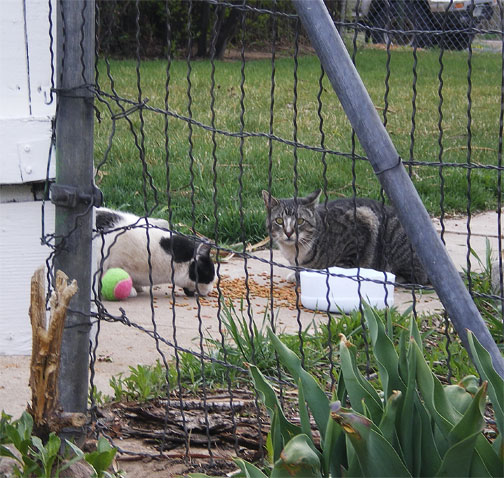What is a Feral Cat?

Feral cats are born and raised without human contact or have been abandoned and reverted to wild ways in order to survive. Ferals often live in groups, called colonies, and take refuge wherever they can find a food source. They also try to seek out abandoned buildings or deserted cars to escape the elements. Unmanaged feral cat colonies are the most underserved segment of companion animals, resulting in extreme overpopulation with dreadful consequences.
Why are there Feral Cats?
“Feral cats are the offspring of lost or abandoned pet cats or other feral cats who are not spayed or neutered. Females can reproduce two to three times a year, and their kittens, if they survive, will become feral without early contact with people. Cats can become pregnant as early as 5 months of age, and the number of cats rapidly increases without intervention by caring people.” ~ Humane Society
How do Feral Cats survive?
“Many don’t survive. If they do survive, their lives aren’t easy without human caretakers. Females may become pregnant as young as 5 months of age and may have two to three litters a year. Being pregnant so young and so often, and having and nursing kittens, is even more stressful on female cats who are struggling to survive. More than half of the kittens are likely to die without human intervention. Males who roam and fight to find mates and defend their territories may be injured and transmit diseases to one another through bite wounds. Feral cats may find food in a restaurant dumpster or someone may feed them. They may find shelter from the elements beneath a porch or in an abandoned building. But often they are without a reliable source of food and adequate shelter. Trap-Neuter-Return is a non-lethal strategy to reduce the number of feral cats and improve the quality of life for cats, birds, wildlife, and people.” ~ Humane Society
Learn more about feral cats at the Humane Societies, https://www.humanesociety.org/news/keeping-neighborhood-cats-safe
What is Trap, Neuter, and Return (TNR)?
Trap-Neuter-Return (TNR) is the most humane and effective way of controlling feral cat populations. It has been used successfully in the US, England and Denmark, and in other forward-thinking countries. At a minimum, feral cats who are TNR’ed are spayed/neutered so they can no longer reproduce, vaccinated, and surgically ear-tipped on one ear (usually the left and is the universally-recognized sign of a cat who has been TNRed). Dedicated caretakers feed and provide shelter for TNRed cats, monitor the cats for illness, and remove new cats for TNR and tame ones for adoption. TNR eliminates the objectionable behavior of unsterilized animals that includes fighting and wandering (looking for mates). It not only controls the unchecked growth of unsterilized cats, but improves the health, behavior and quality of life of the homeless animals.
Learn more about TNR at the Alley Cat Allies, https://www.alleycat.org/resources/how-to-implement-an-organizational-trap-neuter-return-program/
How Do I Trap a Feral Cat?
Please download our Trapping Instructions to understand how to properly trap feral cats. While trapping may seem intimidating, following these steps will help make your efforts successful.
Click to Download Instructions on Trapping Feral Cats
How Do I Schedule a Neuter/Spay Appointment?
The Feline Fix clinic and Dumb Friends League Solutions Clinic are local organizations that provides low cost or no cost spay/neuter cat surgeries. Clinics perform surgeries for tame, stray and feral cats every week. You can schedule a neuter/spay appointment at The Feline Fix or Denver Dumb Friends League by selecting the “Services” tab.
What is Post Surgery Care?
After the surgery, the cats need a temperature-controlled, safe place to recover and should be monitored closely. Once they are ready to return to their outdoor homes, you can continue with your regular colony care.
Click to Download Instructions for Post Surgery Cat Care.
How to Care for a Colony?
“Feral cats typically live in a colony—a group of related cats. The colony occupies and defends a specific territory where food (a restaurant dumpster, a person who feeds them) and shelter (beneath a porch, in an abandoned building) are available. Since feral cats typically fear strangers, it is likely that people may not realize that feral cats are living nearby because the cats are rarely seen.” ~ Humane Society
Learn more about Colony Care at Alley Cat Allies, https://www.alleycat.org/community-cat-care-category/cat-care/colony-care/.




